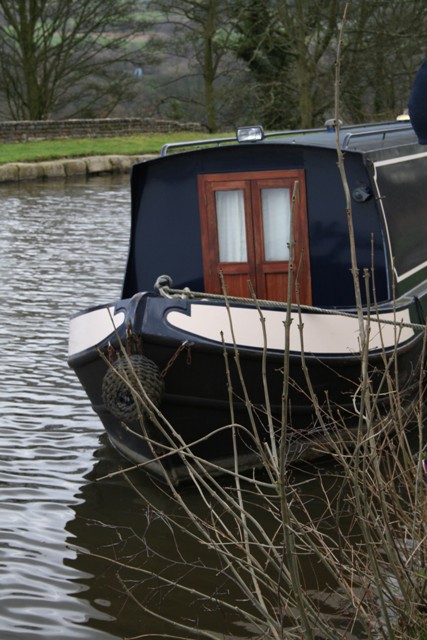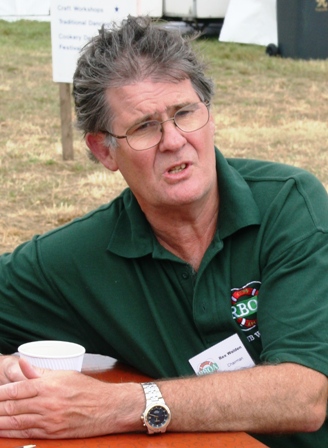
Life afloat: open door policy not shown
Like a boater needs a bicycle
Living off the land
The UK’s waterways offer a valuable recreational resource and are increasingly recognised as an important transport option ripe for revival. But, as Mick Owen discovered, the nation’s rivers and canals also provide a home to a large number of boat-dwellers
Canals and rivers are peripheral to the vast majority of us. Loft dwellers may covet a canal-side location and, given the right weather conditions, a visit to a riverside pub is always a favourite. Some people do go further and take holidays with one of the multitude of hire companies that punt tranquillity and self-regeneration afloat: “Just getting away from it all for a really relaxing and enjoyable break, taking everything at your own pace,” (as they put it at Drifters Waterways Holidays). But for a determined few the waterways are their home. Idyllic it may seem but the still surface of a picturesque mooring often conceals conflict and all too often that conflict is based on different approaches to the environmental challenges that the 4,000 miles of navigable waterways in the UK throw up.
One contributory factor to the tensions that develop around waterways is simply the number and variety of potential users, from that occasional pub-goer walking briefly along a towpath to the multinational firms delivering tonnes of product to the 2012 Olympic site. Even within the waterway-using whole those who live on the water are a rainbow community that ranges from those living below society’s radar using a boat as an alternative dwelling to those from the upper echelons of that very society occupying barely floating gin palaces that shout wealth and influence. And across the cost spectrum an attitude spectrum also pertains with attitudes to ecology and environment as much a signifier within communities as income or perceived status. Anyone living on the water must by definition have a greater awareness of the natural environment than the average house-dweller – they are constantly within a 10mm steel plate of total immersion in it – and, given that the longest of narrowboats is around 70 foot long with the widebeam variety only some 10 feet wide, the act of downsizing just to fit within that particular form of floating home is a significant move towards a smaller carbon footprint.
Once in your floating home the environmental choices are legion. At one extreme of the eco-debate is the community of boaters striving to live sustainably afloat. Under the “low impact life on board” (or LILO) banner they share both common principles and practical information, trying to move forward with their lives while acknowledging “the fundamental interconnectedness of the earth and all living things”. The LILO handbook encompasses choice of fuels for cooking and heating as well the engine, the choice of engine, food storage, hygiene and cleaning, bringing up children, lighting, the best bike to acquire and a long section on toilets and their outcomes. It is easy to scoff at the hint of obsession displayed by anyone at the extreme of ‘mainline’ society but many of the innovations rigged up out of reclaimed timber and inspiration in LILO communities have formed the template for commercial products for the wider market. A commercial boat-friendly compost toilet is rumoured to be coming soon, a crazy notion made real by people with commitment.
Not everyone who seeks to live on a boat is driven by altruism. Many are simply looking for a quieter life in more pleasant surroundings but very few have no regard for the environment. Clutter and waste are the enemy in any small living space but when that space is designed to regularly move around the countryside organisation and prudence if not parsimony are the order of the day. Reducing waste, re-using resources, using one tool for two or three jobs all become first nature and the upshot is a softer footstep in the world. Rex Walden chairs the Residential Boat Owners Association (RBOA) and he is very sure that boat owners respect the environment out of a mixture of necessity and inclination. He is also of the opinion that people who do not understand the givens of the lifestyle should be dissuaded from adopting it.
“Part of our role is very much about persuading people who think they want to live on a boat that really they don’t,” he said. “The realities of living aboard can be harsh, especially in the winter, and simply wanting cheap accommodation is not enough of a motivation.”
He has a slew of tales of boats bought and paid for that sit idle in expensive marinas as the new owners realise that they have no affinity for life on board. He regrets the waste. While living aboard can be fabulous he warns that “whether you want to replicate the mod cons you have in your house or have a real desire for a simpler and more sustainable existence, the bottom line is where is the necessary energy coming from and how much is going to be available.” It appears that whenever boaters gather the conversation turns to toilets and electricity, and in both cases boat dwellers are careful how they use them.
Curiously, given how nice they all seem, boaters have enemies, or at least opposition, and not always just from the ranks of shiny new canal-side home owners who object to the waterway they bought a house beside being used as anything other than a backdrop to their own lives. Ecologists seem to have an issue, or issues, with the boating community and opposition to the lifestyle comes from unlikely sources. The Royal Yachting Association has joined forces with the British Marine Federation and gone to war with elements of their own marketplace under the banner of ‘The Green Blue’. The leaflet setting out the aims of the campaign looks at a number of areas and leads in each one with the heading: “What’s the problem?” In every case it implies that the problem is boats. But, as Walden points out, “Canals were built to have huge chunks of metal – or if you want to be purist – huge chunks of wood floating in them. They were built to be used. Every drop of liquid that leaves my bilges [he owns a 70 foot narrowboat named Winifred] came from the heavens or out of the canal itself. Yes it may have picked up a little rust along the way but what’s unnatural about iron oxide?” He is also exercised about ‘grey water’ generated by washing people, dishes and on some boats even clothes. The by-product of these activities goes straight into the water around the boat but as long as the detergent used is non-toxic – and suitable products are readily available – there is no threat to wildlife. He counters what he clearly considers to be hysterical claims that “one teaspoon of Fairy Liquid ‘kills’ X feet of river” with a recital of the wildlife at Winifred’s home mooring: “We have fish this big [and it is a fisherman’s measure] in the marina where we have our mooring and prolific bird life, including heron, grebe and even tern. And they aren’t supposed to come that far inland. Ducks love it when you pull the plug on the washing up water. If the cleaning medium is carefully chosen then the rest is a banquet. Everything that enters the ecosystem from the vast majority of residential boats is organic.”
The RBOA and its big sister, the Inland Waterways Association (IWA), which represents “over 18,000 members whose interests include boating, towing path walking, industrial archaeology, nature conservation and many other activities associated with the inland waterways”, are campaigning organisations and to good effect. Since 1946 the IWA has been fighting for the canal system to be saved and revitalised. In recent years through relentless campaigning to change policies and attitudes the organisation has prevented the Llangollen Canal, the Southern Oxford, the Leeds & Liverpool and many others from being abandoned and forgotten. Through their Waterways Recovery Group they have helped to restore and re-open waterways like the southern Stratford Canal and River Avon navigations.
And they are prepared to take their fight to the highest levels. Currently the IWA, alarmed at the depth of a cut in grant-in-aid of nearly 17% for British Waterways next year (2010/11) and concerned that the Environment Agency will receive similar treatment, has launched into government. Clive Henderson, IWA national chairman, has said: “We believe that the threat of under-investment in the waterways must be addressed by all stakeholders in the waterways – now. Government is slashing British Waterways’ budget and unless we stand up to this we can expect more of the same.” Being waterways people, rather than simply complaining the association is seeking “to identify, in partnership with local navigation authority managers, issues of poor maintenance and slipping standards – especially those affecting safety. The collection of evidence about problems caused by under-funding locally will allow us to build the national picture so that no-one can deny the effect of these cuts and so that the under-funding can be reversed.”
It all seems a little quixotic but windmills sometimes back off, as Huntingdonshire District Council recently discovered when faced with a precedent-setting development control issue. Essentially the council have decided that declaring more than 100 households illegal is counter-productive and a local decision has been made. The precedent set, that decisions about waterways related planning issues should be made locally, will impact in many cases where ‘the law’ is currently being invoked. It this type of common-sense advocacy that makes the case for seeing boaters and boating as a positive force for a more balanced system, whether that system be ecological or sociological. Rex Walden makes the case for the latter: “You find all types of people sharing a mooring, from a barrister to a road mender, and every layer of society, every level of income in between. All these different types of people know each other’s names, help each other out and benefit from the very real sense of community.”
This is a counter to the dissolution of society that results in boats being pelted with rocks by disaffected youths or lock pounds being emptied by urban vandals. The nature of canal and river dwelling means that boaters’ inclination is to live in harmony, either with other boaters, other humans or the natural environment. Water voles may well be a threatened species but they are not threatened by passing canal boats. The growing mileage of navigable waterways is used by far more people then ever get in a boat but without their passage the ‘green corridors’ would soon silt up again. And yet there seems to be a great deal of work required before appointed and self-appointed guardians of everything from damselflies to flood plains accept narrowboats and their occupants as an entirely valid part of the canal and river system. It might take a while but nobody seems phased by big jobs when it comes to the waterways.
The Leisure Review, November 2009
© Copyright of all material on this site is retained by The Leisure Review or the individual contributors where stated. Contact The Leisure Review for details.
Download a pdf version of this article for printing

Life afloat: open door policy not shown
Like a boater needs a bicycle
